
views
Finding a Good Position

Find the location of the sun. This method will work best if the sky is clear and there are no clouds. However, if it’s cloudy, or the sun is obstructed by trees, you may have to approximate. If it is cloudy and you can see a vague outline of the sun, you can still do the measurement between the horizon and the sun. There will be a haze around the sun in the clouds: use that haze as the position of the sun. Your calculation may be a bit off, because the haze around the sun is larger than the sun itself, but it will only be by a factor of a few minutes. If it's cloudy and you can't see the sun at all, you won't be able to use this technique. However, if you have a feeling that the sky may clear up, wait ten or fifteen minutes to see if you can see the sun.
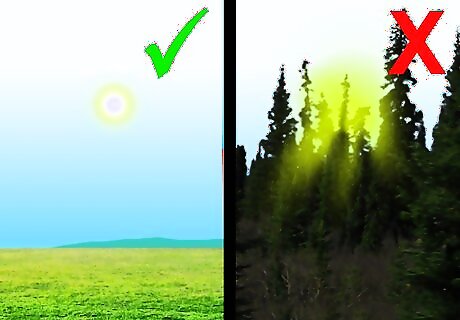
Get a clear view. If your view is blocked by trees or other items on the landscape, you’ll need to find some higher ground where the view is better. Hike or climb up a bit until the sun is unobstructed in the sky and you can see the space between the sun and the horizon. If the terrain is very hilly and there's no possibility of climbing higher, walk as much as you can to see if you can locate the sun. If you're able to get a bit of a hint of where it is, you can use the method with the approximate location of the sun. If trees are blocking your view, make an approximate guess as well. You'll still be able to see a vague outline of the sun, which will be good enough for a measurement.
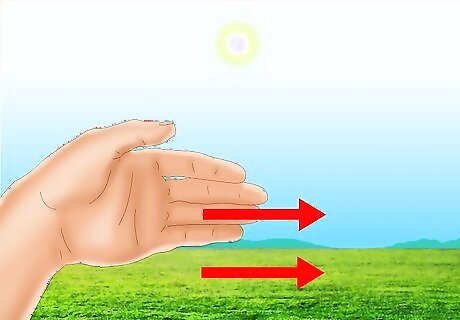
Get into position. Hold up one arm with your wrist bent so your palm is facing towards you. It doesn’t matter which hand you pick, left or right: whichever feels most comfortable. Position your hand with your fingers together and your palm flat. Hold the bottom edge of your hand (the side of your pinky finger) parallel to the ground. You’ll want to take a comfortable stance for this trick, because you’ll have to hold your hands and body still for a while. Make sure that the ground beneath you is solid: no moving rocks, shale, or uncomfortable footing. This could affect the accuracy of your measurement.
Measuring With Your Hand
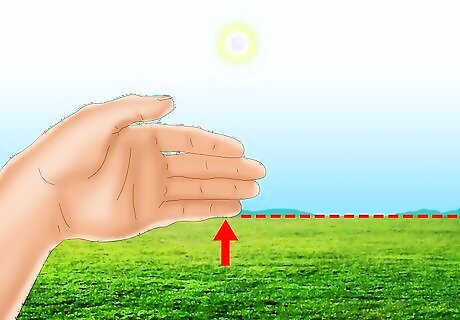
Line up your hand with the horizon. Hold it so that the bottom edge of your hand is “resting” on the horizon. The bottom edge of your hand will be directly in line with the line between the land and the sky. You’ll want to hold it still and as close to parallel as you can to get the most accurate measurement possible. No matter your location, the horizon should be a flat line between the sky and the ground. If you can't get a good view of the horizon due to mountains, trees or other obstructions, you'll have to make an approximate guess. Your measurement won't be perfect, but you'll at least have a general idea how many hours you have.
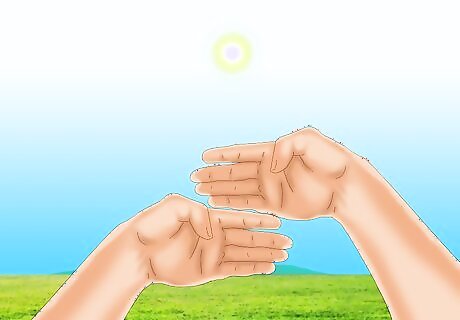
Stack your second hand on top of your first hand. If you can still see distance between the top edge of your hand and the sun, you'll need to take a second hand measurement. Holding your first hand still so that you don’t lose its position, place your other hand directly on top of it in the same flat, parallel way as your first hand. Keep your hand still and prepare for another movement. If you do this correctly, the top edge of your first hand, your forefinger, will be lined up with the bottom edge of your second hand, your pinky finger. Keep your thumb out of the way; only your four fingers should be factored into the measurements.
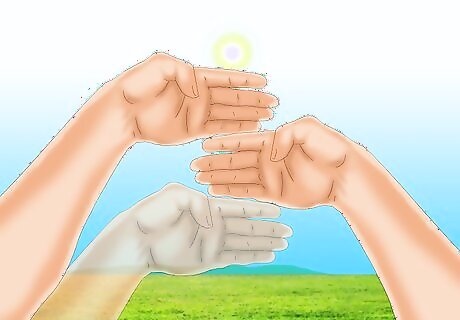
Stack your first hand again. If you can still see distance between the top edge of your hand and the sun, you’ll need to measure with your first hand again. Holding your second hand steady without moving it, remove your first hand from below it and place it on top of your second hand. Keep your second hand still so you don’t lose your place.
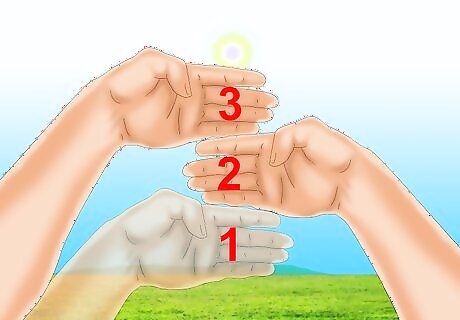
Keep count. As you move your hands, stacking them on top of one another, remember how many hand widths you’ve measured. The count is a measurement of how many hand widths are between the horizon and the sun. If the number of counts is large or you can't remember, ask a friend if you're in a group. You can stack your hands while the friend keeps count. If you're alone, you'll have to count carefully by yourself. Speak out loud as you stack your hands, adding each stack vocally instead of in your head. This will help you remember.
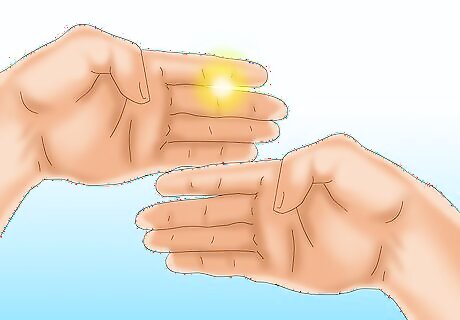
"Touch" the the sun. Keep stacking your hands following the same method one until one of your hands reaches the sun. It's fine if the sun is partly obscured by one or more of your fingers. The exact position of your fingers will factor into your calculation of how much time is left before sunset, so be sure to hold your hand in place.
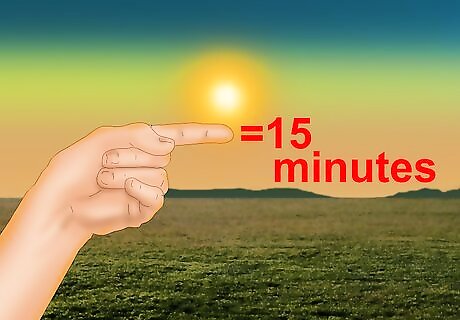
Use only fingers to measure late in the day. If it’s later in the day and the sun is so low that you can’t fit your whole hand between the horizon and the sun, use only your fingers to measure the distance between the horizon and the sun. They’ll still be worth 15 minutes each.
Calculating the Hours
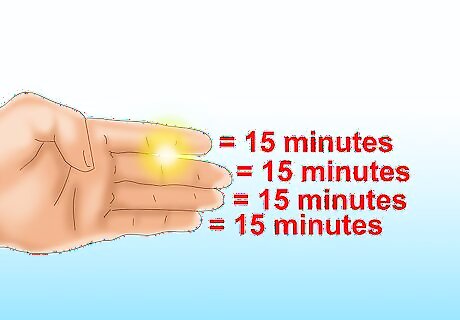
Note the final position of your hand. Look to see how much of the sun is "touching" your fingers. Since each finger on your hand is equal to 15 minutes, the difference between one finger and the next will be a significant amount of time left until dark. Leave your thumb out of the calculation. If the sun appears to be sitting on the top edge of your hand, no additional time should be added. If the sun is obscured by your forefinger, you'll add 15 minutes to your total count. If the sun is obscured by your forefinger and middle finger, you'll add 30 minutes. Keep adding an additional 15 minutes for every additional finger that obscures the sun.
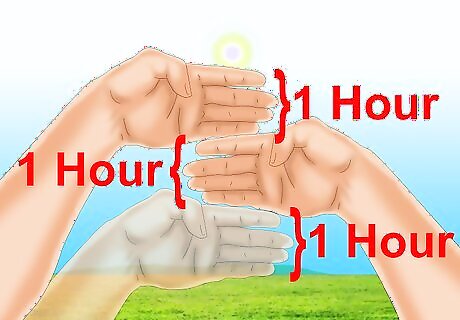
Total the counts. Each hand is worth an hour, so you'll want to know exactly how many hands you stacked. If you forgot your count at any point in the stack, go ahead and start over. Add up the number of times you stacked your hands: 1, 3, 5, etc. If the top of your hand lined up perfectly with the sun, you’re done with your total. The number of hands stacked simply equals the number of hours left until dark. Four hands stacked would equal four hours of sunlight. However, the sun was positioned on one of your fingers, you'll have to do more addition.
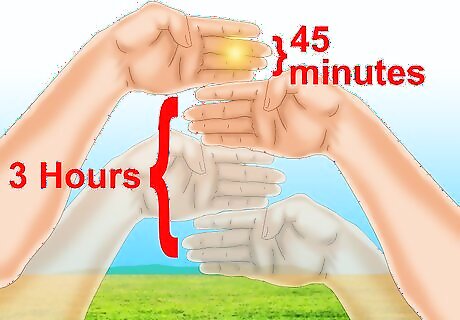
Add up the hand widths and finger widths. Remember that each hand-width measurement is equal to one hour of time before sunset. Each finger-width measurement is equal to fifteen additional minutes. For example: if it took you 3 widths of your hands to "touch" the sun and the sun was positioned over your forefinger, middle finger and ring finger, the distance between the sun and the horizon would be three hand widths and three finger widths. Three hands widths equals three hours. Three finger widths equals 45 minutes (15 minutes each). Therefore, you would have 3 hours and 45 minutes before sunset.




















Comments
0 comment